What parent hasn’t cursed steps and stairs as they’ve hauled a baby laden stroller up them? Or protected sharp corners from impact by a pre-schooler’s head? Who hasn’t slipped in the shower and reached out for something substantial to hold onto?
We've heard that oft touted figure that we spend 90 per cent of our time indoors. But let’s consider that from another angle — 90 per cent of our lives. For Australians that is around seventy plus years. Inside buildings.
So what would our buildings look like, if their design considered this passage of human life? What parent hasn’t cursed steps and stairs as they’ve hauled a baby laden stroller up them? Or protected sharp cornered fixtures and furnitures from impact by a pre-schooler’s head? Who hasn’t slipped in the bath or shower and reached out for something substantial to hold onto? Or how many ageing Australians with failing eyesight have tripped crossing the threshold of their own homes?
The Centre for Excellence in Universal Design, in Ireland, notes that, “No person operates with full capability for every activity for the duration of his or her lifetime.”
The most simple of human needs can be challenging for many people. For example, the Changing Places project note that around 200,000 Australians require assistance to use the toilet.
In a report released last year, the Australian Institute of Health and Welfare indicated that 18.5 per cent of our population have disability. And another 12 per cent “provide informal care to an older person or someone with disability or a long-term health condition.” That’s eight million Australians dealing with reduced capabilities.
We know that as age increases, our capability and mobility decreases. We become less able. Dis-abled, if you will.
And, in case you hadn’t heard, Australia is getting older. About 40 years ago eight per cent of our population was aged 65 and over. Now it’s more like 14 per cent. And in that period, those 85 and over increased almost four fold. In the next twenty years Australia population is projected to grow by 28 per cent, whereas growth for those in the 65 and over age bracket is expected to increase by 82 per cent, and greater than 100 per cent for 85 and overs.
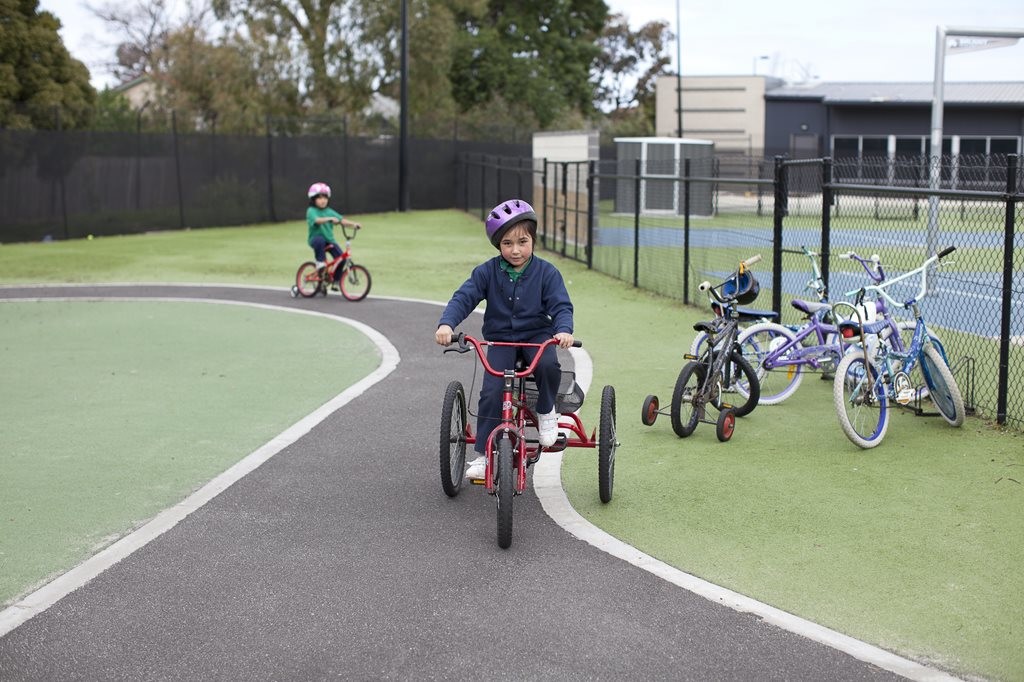 Melbourne’s Hede Architects specialise in access design and were responsible for the award winning Kindergarten to Year 12 Western Austistic School. Images: Victorian Government
Melbourne’s Hede Architects specialise in access design and were responsible for the award winning Kindergarten to Year 12 Western Austistic School. Images: Victorian Government 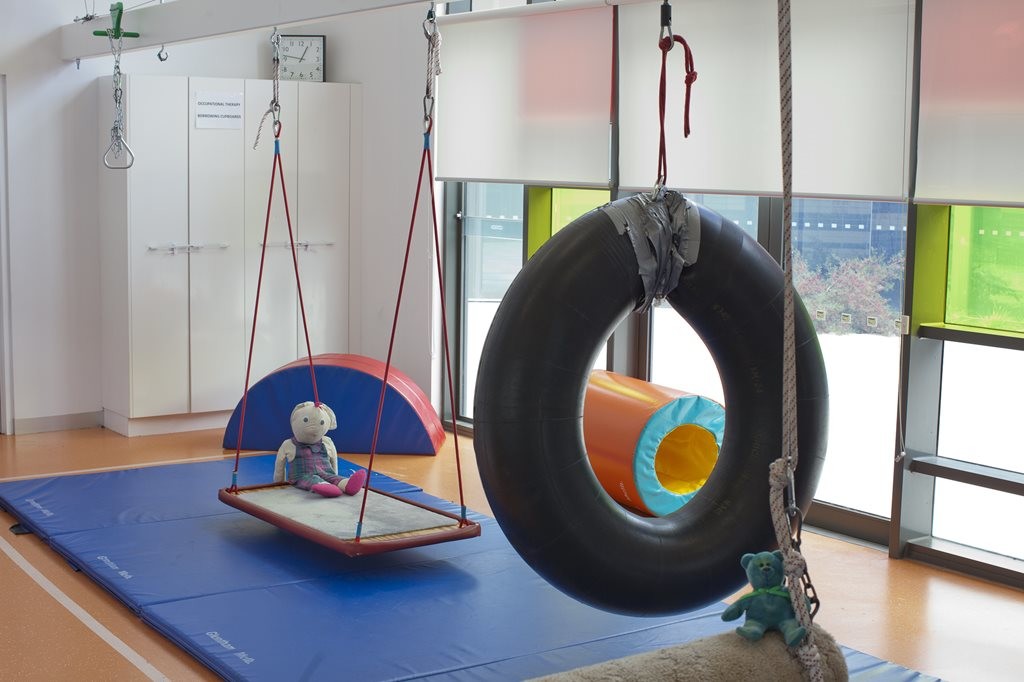
Such figures explain why agencies involved in health, aged care, pensions, retirement, superannuation, etc, are galvanising into action.
But what of the architectural profession? Is it doing all it can to future proof our buildings.
Certainly the Building Code of Australia does address the issue with their Disability Access Provisions. But even the Australian Building Codes Board (ABCD) acknowledge that “There have been many successful DDA [Disability Discrimination Act] complaints about buildings which were BCA compliant,” observing that in a case against the Brisbane Convention Centre, the cost of rectification was in the order of $300,000.
How then to proactively avoid such issues? By thoughtful, responsible design. The ABCD again: “Good design is not just about providing some access. It is about ensuring, as far as possible, that people with disability can use buildings independently and with dignity.” And importantly, recognising that, “Good access has benefits for a much wider group of people than those who currently have a disability. For example, those of us who will have a disability in the future, families with small children, older Australians and anyone delivering or picking up goods.”
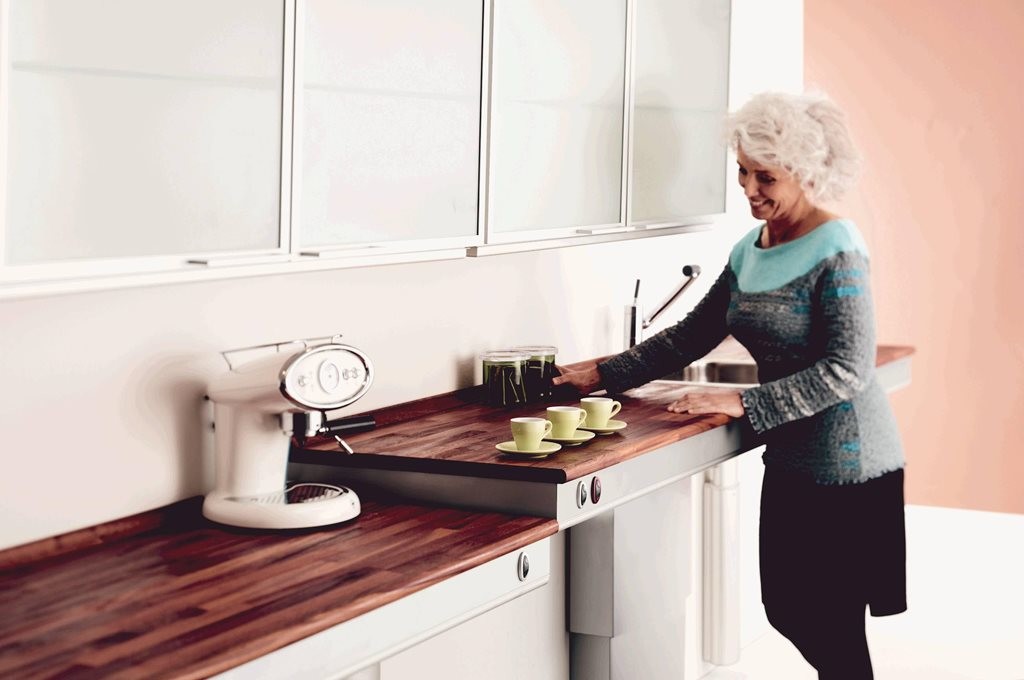 Indivo lifts from Enware enable the height of all wall cupboards and worktops in a kitchen to be adjusted, allowing for both seated and standing users to work comfortably.
Indivo lifts from Enware enable the height of all wall cupboards and worktops in a kitchen to be adjusted, allowing for both seated and standing users to work comfortably.
Design that is responsive to the lifelong needs of people has been given many names: Access design, Universal design, Inclusive design, Adaptive design, Design-for-All and Lifespan design, and more. But it is important not to get hung up on the nomenclature, and focus rather on the outcomes. That is; products and spaces that work for every member of society.
 The Design Council of the United Kingdom acknowledges that such design work isn’t always considered sexy. “… at the moment accessibility is all too often seen as a bolt-on. Design professionals are talented, skilled people but they aren't always great at putting people at the core of the design process - at being inclusive.” [An observation clearly demonstrated by architectural photography, which rarely shows people interacting with buildings. If they are grudgingly included, they appear only as blurry, indistinct ghosts, wafting through the structure.]
The Design Council of the United Kingdom acknowledges that such design work isn’t always considered sexy. “… at the moment accessibility is all too often seen as a bolt-on. Design professionals are talented, skilled people but they aren't always great at putting people at the core of the design process - at being inclusive.” [An observation clearly demonstrated by architectural photography, which rarely shows people interacting with buildings. If they are grudgingly included, they appear only as blurry, indistinct ghosts, wafting through the structure.]
>Large light and power switches such as the Presitge range from Schneider Electric benefit not only those with a vision impairment but are easier for all of us to use.
Yet architects and designers are doing their clients a disservice if they ignore this important aspect of design. 83 per cent of disabled people in the UK have 'walked away' from making a purchase, unable or unwilling to do so, with inaccessible premises being the most important factor.
Maybe what designers need is simply a fresh way of looking at the issue. In his book Design Meets Disability, Graham Pullin notes that eyeglasses were once a medical aid for people with impaired vision. But now glasses are a fashion accessory. Pullin’s book was published in 2009 and at the time he questioned why hearing aids couldn’t also be as fashionable as eyewear. Have you seen hearing aids of late? No longer bulbous lumps of flesh coloured plastic, they are now streamlined orbs available in every colour of the rainbow, with some styles being controlled by iPhone Apps.
Buildings too are seeing a subtle, if slow, change in this direction. Observe the trend to sill-less showers, with their accompanying smart drainage panels. Such design not only looks sleek and contemporary, it assists those less able. Reducing obstacles to access, reduces falls. And this can only be advantageous for us all. A British report found that “Falls are the commonest cause of death from injury in the over 65s” and that cost the National Health in that country more than 3.6 billion dollars per year. Not including the “knock-on effect on productivity costs in terms of carer time and absence from work.”
Extended lever handles are beginning to become more common and are great for care facilities or those with restricted movement. Image: Nordic Care Mixer from Caroma.
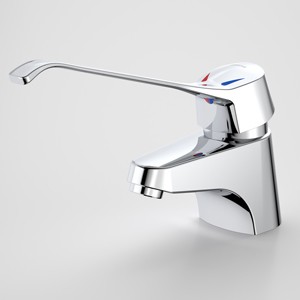
Who wouldn’t appreciate bathroom, laundry or kitchen taps that can be adjusted by small children, folk with arthritis, or hands dripping in mango juice? Most tapware manufacturers now offer a stylish domestic version of the extended lever style of tap favoured by hospitals.
Large light and power switches benefit not only those with a vision impairment but are easier for all of us to use. Fine gauge stormwater drain grating gets the thumbs-up from people with walking sticks, but also wearers of high heels and skateboarders.
A very able and mobile friend just completed a major renovation of her kitchen and she went with large drawers instead of cupboards, so she could easily reach all her dishes, utensils and stuffs. Little did she know that my wife’s uncle has the same kitchen set-up. The difference being he is an amputee in a wheelchair. Very different lifestyles, near identical kitchen fit-out.
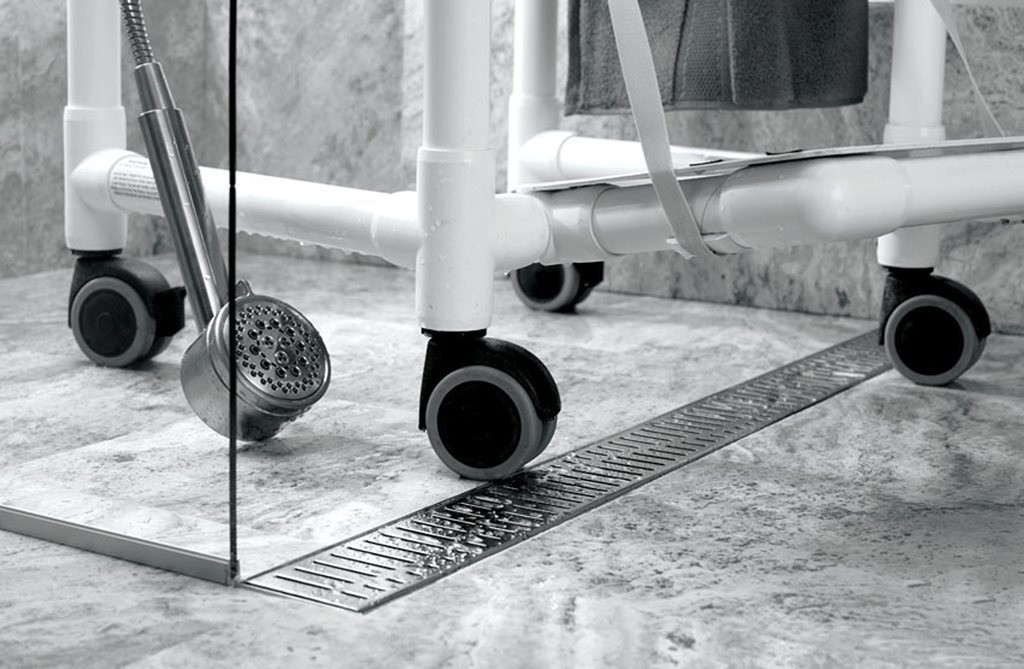 Sill-less showers and their accompanying smart drainage panels such as this ShowerChannel - Wave from ACO are stylish and remove a common cause for accidents in the bathroom.
Sill-less showers and their accompanying smart drainage panels such as this ShowerChannel - Wave from ACO are stylish and remove a common cause for accidents in the bathroom.
Universal, inclusive design, or whatever you wish to call it, goes beyond the common understanding of disability. Anyone who has travelled internationally, will know that well designed pictograph signage has allowed them to find their way to train stations, toilets, public phones, etc. Design for all, regardless of their language abilities.
When applied to housing, this form of forward thinking design, under such banners as Adaptive or Lifelong design ensures dwellings will retain a practical functionality for whatever phase of life the residents are in. Floor coverings may extend from wall to wall, allowing for cupboards to be removed later, facilitating knee-space for wheelchair users, or those who can’t stand for long. And without requiring any costly re-laying of linoleum or tiles.Adjustable benches, shelving, and the like, suit parents trying to keep items out of reach of a toddler, yet later allow a preschooler to reach their own toothbrush. They give a 1.5m or a 1.8m tall person the equally correct bench height for preparing meals, and provide wheelchair users with their Optimum Reach Zone.
A step-less building entry is equally appreciated by furniture movers unloading for young homeowners, who will later love it when they push a pram, or welcome ageing parents into their house for visits. And indeed become older and less mobile themselves.
The US-based Institute for Human Centered Design posits that, “Universal Design and green design are comfortably two sides of the same coin but at different evolutionary stages. Green design focuses on environmental sustainability, Universal Design on social sustainability.” I would go further and suggest that they are one and the same. A home that is not continually remodelled to suit changing lifestyle needs, uses far less resources, placing less extractive burden on our already depleted natural environment.
Such design thinking does not mean launching out into the unknown. Victor Papanek, pioneer of ‘design for the real world’ was working away in this field in the 1960’s. Here in Australia we are well provided with a host of organisations and businesses that support this important sphere of endeavour.
We have the Association of Consultants in Access Australia, the Australian Network for Universal Housing Design, Home Modification Information Clearinghouse, Independent Living Centres Australia, and Livable Housing Australia, to name but a few. Even the venerable government initiative Your Home has a chapter on “The livable and adaptable house.”
There is also Able Access Design, a consultancy founded by an architect who sustained a spinal injury. Australian Disabled Access Consultants whose work spans Australia and the Middle East. Hede Architects who designed an award winning Kindergarten to Year 12 school for Autistic students. The Hendry Group, who work as disability access consultants to Australian Standards. And we could go on.
As usual, we have exceeded our allocated word count, yet barely scratched the surface of Universal Design, haven’t even mentioned its seven principles. Here’s three: Useful for people with diverse abilities, Flexible in use, and Simple and intuitive to use. Who wouldn’t want their design to include those? Or the notion of the User as the Expert. What a concept!

